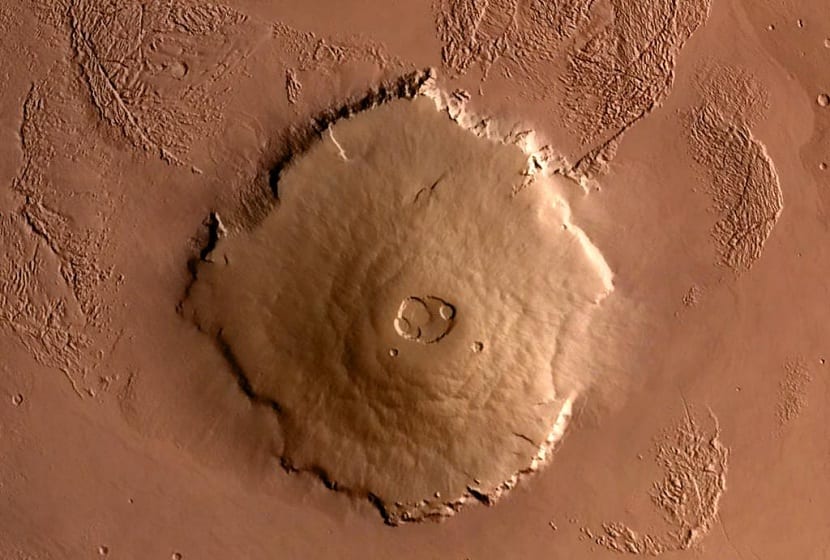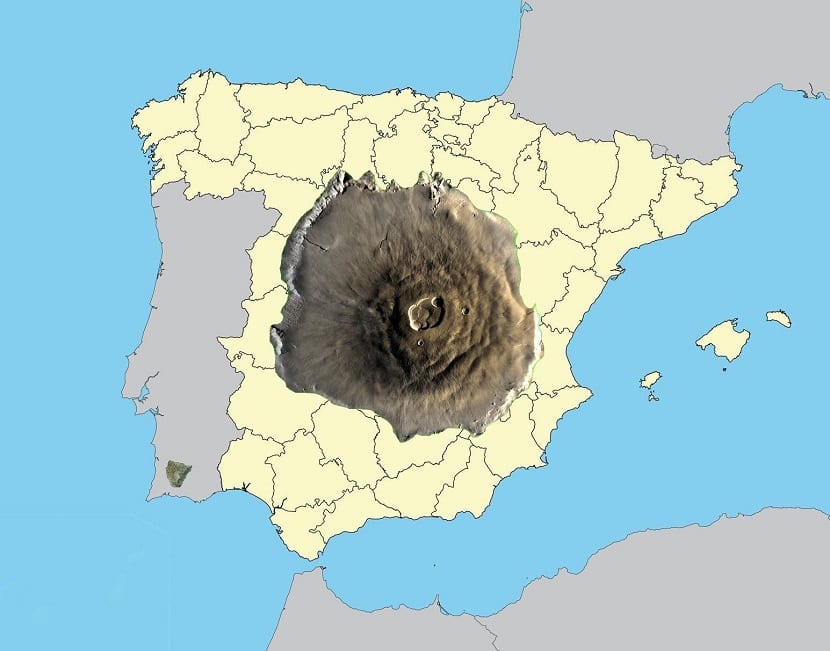
When we see some of the largest and most majestic mountains on our planet, such as the Appalachian Mountains and himalayan mountain range, we think that there can be nothing superior to it. And it is that we cannot be more wrong in that. Although Earth is the only habitable planet in the world Solar system, is not the only one with fascinating morphologies and geological structures. Today we move to the planet Mars, where we have the largest known volcano in the entire Solar System. Its about Mount Olympus.
Don't miss all the details about this gigantic volcano, its origin and how it was discovered.
Key features

The planet Mars has been of great interest to humans since its discovery. There are numerous studies and expeditions with probes have been carried out to discover not only the terrain but the interior of the planet. At present, the InSight probe has come to Mars to see all its insides. Better images and more information can be collected every time given the great development of technology that we have experienced in recent decades.
Mount Olympus was already known from ancient expeditions, since spacecraft approached the planet and it could be visualized. However, the details of this majesty were not well known. It is the youngest volcano on the red planet and has been formed approximately 1.800 million years ago.
It has a central massif with a height that rises up to almost 23 km high. We remember that the largest peak on Earth does not exceed 9 km. Around it it has a vast plain that surrounds it. It is observed that it is located in a depression of a depth of 2 km and there are quite a few huge cliffs with almost 6 km height. Imagine the size of this volcano, compared to what we have on Earth. A single cliff is higher than any peak in the entire Iberian Peninsula.
Among the characteristics of the interior of the volcano, we see that its caldera has dimensions of 85 km long, 60 km wide and almost 3 km deep. It is really a beast of a volcano worth seeing, even in photographs. It has 6 chimneys that have been formed at different times of the year. The base of the volcano is about 600 km in diameter.
Size and shape

Mount Olympus if it were in Spain
If we see the total of the base, we see that It occupies an area of 283.000 square km. This is the same as the area of half of the Iberian Peninsula. It is difficult that these dimensions can be imagined, since they are enormous. A volcano that occupies half of Spain is not something easy to imagine. In fact, its size is such that if we were to follow the soil of Mars, we would not be able to see the shape of the volcano completely. Even if we were to move away, we would only see a wall that looks like a huge cliff.
It can only be seen completely from above, since the curvature of the planet would limit our observation to the horizon. Like It cannot be seen completely from the ground, not even from the top. If we were to perch on the highest peak of the volcano, we could only see part of its slope. We would not get to see the end, since it would blend into the horizon. If we want to see Mount Olympus in its entirety, the only way is from space on a ship.
Analyzing the type of volcano that is Mount Olympus, we can say that it is shield type. Shield volcanoes are characterized by being wider and taller and having rounded and flat shapes. They are more like Hawaiian-type volcanoes.
This enormous size has its explanation and its origin. And it is that the dynamics of the planet does not work in the same way as ours. Does not have tectonic plates that are in motion and move the continental crust. For this reason, Mount Olympus has been continuously generating lava in the same place and has been solidifying, obtaining such size.
Origin of Mount Olympus

As we know, this large volcano has been the subject of investigations to find out its origin. The eruptions of the volcano are thought to have formed the crater that it is today. Since Mars has no tectonic plates, the surface is fixed. In this way, the expelled lava has solidified to form this relief.
This volcano has modified the entire face of Mars. The debris from the volcano was what formed the great plain that lies at the foot of the ridge, called the great plain of Tarsis. It is an area that is 5.000 square km and 12 km deep, taking into account that the red planet is half as big as ours. This changes the way Mars looks completely.
The pressure action of this huge platform has been displacing the surface layer of the planet and moving all areas of the crust to the north. Scientists believe that because of the appearance of this volcano and its slow formation, the poles of Mars are no longer at the poles, and all the river courses have shifted so much that they have died.
If something like that had happened on our planet, the city of Paris would be part of the Polar circle, since Mount Olympus would have displaced the rest of the earth's surface.
What scientists are seeing is that this huge volcano, may erupt again as some research concludes. It is incredible how on other planets, nothing more than having another kind of dynamics can cause formations of this type to originate. The fact that Mars has other internal dynamics and does not have those convection currents that move tectonic plates, a single element such as a volcano, can give rise to huge formations that make it the largest mountain in the Solar System.